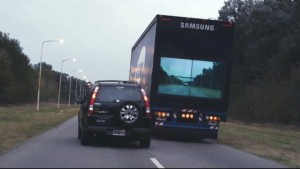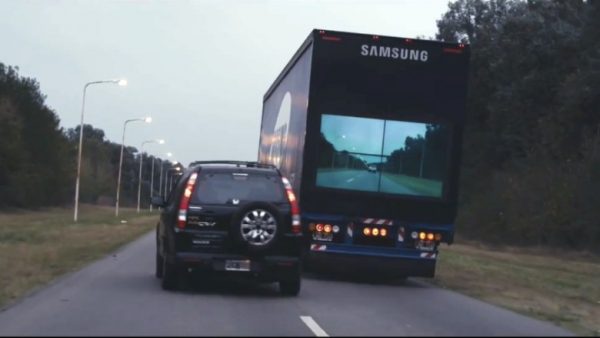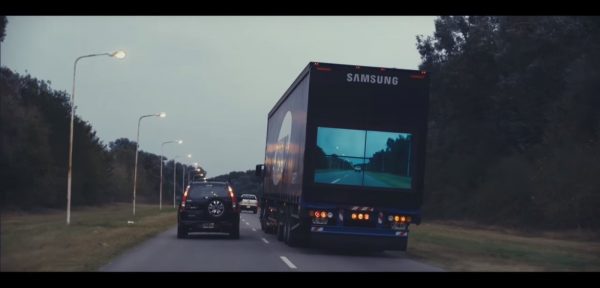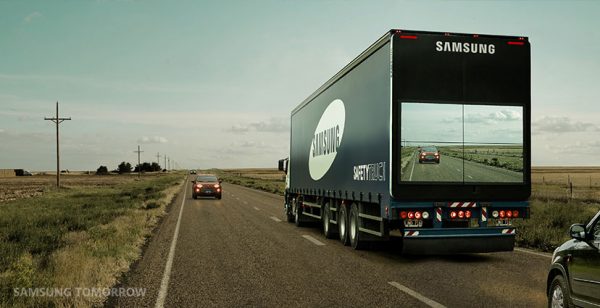The video came out six months ago, but is still being posted on social media. It’s from Samsung and shows what’s described as a Safety Truck driving down a road in Argentina. Cars pass it after seeing that the road ahead is clear via a video display.
Samsung explains, “The Safety Truck consists of a wireless camera attached to the front of the truck, which is connected to a video wall made out of four exterior monitors located on the back of the truck. The monitors give drivers behind the truck a view of what is going on ahead, even in the dark of night.
“This allows drivers to have a better view when deciding whether it is safe to overtake. Another advantage of the Safety Truck is that it may reduce the risk of accidents caused by sudden braking or animals crossing the road.”
Why Argentina? The company said, “Argentina’s statistics on traffic accidents are among the highest in the world, with most of these accidents occurring on two-lane roads and particularly in situations of overtaking.”
While the prototype truck is no longer operational, Samsung “has been able to confirm that the technology works and that this idea can definitely save the lives of many people.”
But is it really a good idea? Watch the video, read what RIDE-CT & RIDE-NewEngland’s staff has to say, and then add your own comment:
Here goes with the staff opinions.
Opinion #1:
Quick, let’s enter the Samsung Safety Truck into this years’ competition for Clever Idea That Was Clearly Not Thought Through. I  chalk this up to another application of current technology that gets high marks for technical execution and very low marks for suitability of use in the real world.
chalk this up to another application of current technology that gets high marks for technical execution and very low marks for suitability of use in the real world.
Why the trash talk about this visually appealing concept? Because in actual use on the roadways of the world, this rolling video game would prove to be the ultimate distraction to anyone following the big rigs with the big screens. At its simplest level, seeing the road ahead of a large truck blocking your view does have some appeal. If the potential impact (pun intended) of this scenario is limited to the very narrow situation as demonstrated in the video, perhaps the idea could be a winner.
But, the real world doesn’t work that way. Imagine a line of vehicles following the Safety Truck. A row of vehicles, not just the one directly behind the truck. Now, put a huge movie screen in each driver’s frontal field of view. Don’t we think that in-vehicle entertainment systems, cell phone conversations, texting, and passenger distractions already take up too much of a driver’s attention? Anyone with a little imagination can visualize a whole host of really bad outcomes.
Besides, you’ll never see this technology rolling down the highways of America. Imagine you’re a fly on the wall in a major transportation-oriented company’s conference room. The senior members of the legal department have just viewed this video. Now, see if you can conjure up some of the liability-laced commentary that makes its way around the table. Sounds like an opportunity to break for an early lunch.
Opinion #2:
The Samsung Safety Truck experiment in Argentina is an interesting attempt to mitigate the serious problem in that country with  regard to the large number of vehicle accidents. At this point it is a one-off experiment and not being promoted globally. Would it ever be accepted by government safety organizations and work here? Who knows.
regard to the large number of vehicle accidents. At this point it is a one-off experiment and not being promoted globally. Would it ever be accepted by government safety organizations and work here? Who knows.
As audio-visual technology advances we will see more of it introduced into and impacting our lives. Cell phones capture life’s moments in photo and video. Go-Pro revolutionized motion sports hi-def video. Law enforcement began using dash and body cams. The technology moved into our vehicles not just to visually log our adventures, but it is also being used to collect potential evidence for the unlikely accident or encounter.

I feel the Safety Truck represents one of those cool technology applications we don’t think we need. I can see how it can be a distraction to drivers behind. One of the hindrances of this application is that a fixed camera’s view does not offer the same breadth of visual detail and depth perception as our eyes. With a single glance we are able to see, perceive, and process a large amount of visual data from our central vision area out to the fringe of peripheral vision. The camera may not accurately portray speed and distance in a manner that everyone can perceive.
This was a first public attempt with this type of technology, and I do expect it to mature more and be integrated into vehicles at some point. Auto manufacturers have introduced new technologies to improve vehicle safety for years, with a recent seemingly advance toward the autonomous vehicle. Many cars now have ABS, traction control, rear view cameras and blind-spot detection. Adaptive cruise control/collision mitigation is not just a luxury vehicle feature now it has been implemented into the mainstream like Subaru’s Eyesight.
Opinion #3:
My initial reaction after watching the video was, “Wow, that’s cool.” Then I thought about rolling up behind such a truck on an Interstate  highway. How easy it would it be to become dazzled by the images on the screen, not notice that driver had urgently applied the brakes, and ride right into the trailer?
highway. How easy it would it be to become dazzled by the images on the screen, not notice that driver had urgently applied the brakes, and ride right into the trailer?
Technological advances do have their place. ABS saves lives. Back-up cameras on cars make life easier. But not every advance is an improvement. I detest throttle-by-wire on motorcycles because of their “touchiness.”

My gut says that if a rider is close enough to get a truly good picture of the road ahead, that rider is probably so close as to not be able to see the rear-view mirrors of the truck – meaning the truck driver cannot see the rider. How dangerous is this?
Given the propulsion power of most motorcycles, from a rider perspective, a safer move than watching the tube would be to hang back, give a good look ahead and pass when it’s appropriate. For cars, though, it might be a different story. I vote thumbs down.
How do you vote?
 Ride CT & Ride New England Serving New England, NYC and The Hudson Valley!
Ride CT & Ride New England Serving New England, NYC and The Hudson Valley!




